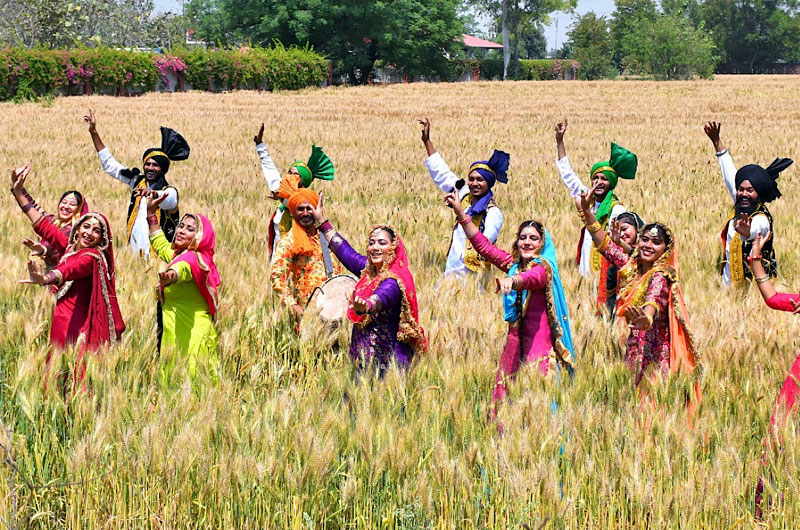
Festivals of Haryana
Haryana, located in northern India, celebrates a variety of festivals that reflect its rich cultural heritage, traditions, and agricultural significance. These festivals are marked by religious fervor, vibrant celebrations, and community gatherings.
Teej
Time of Festival
- July/August
Specialty of the Festival
- Significance: Women’s festival celebrating marital happiness and prosperity.
- Activities: Women dressed in colorful attire, swings (jhulas), traditional songs, and dances.
Locality of the Festival
- Celebrated Across: Haryana, especially in rural areas and among married women.
Nature of the Festival
- Type: Cultural and social
- Description: Teej is a significant festival celebrated predominantly by women in Haryana to pray for the well-being and longevity of their husbands. Married women dress in colorful traditional attire, apply henna (mehndi) on their hands, and participate in swings (jhulas) adorned with flowers. They sing traditional Teej songs, dance to folk music, and exchange gifts with each other. The festival highlights the cultural values of love, devotion, and harmony in marital life among Haryanvi women.
Holi
Time of Festival
- March (Phalgun Purnima)
Specialty of the Festival
- Significance: Spring festival of colors symbolizing the victory of good over evil.
- Activities: Colorful powder (gulal) throwing, music, dance, and festive delicacies.
Locality of the Festival
- Celebrated Across: Haryana, with major celebrations in cities like Karnal, Ambala, and Hisar.
Nature of the Festival
- Type: Cultural and social
- Description: Holi, the festival of colors, is celebrated with enthusiasm in Haryana as elsewhere in India. It marks the arrival of spring and signifies the victory of good over evil. People gather in open spaces, throwing colorful powders (gulal) and water at each other in a joyous atmosphere of music and dance. Traditional Haryanvi folk songs and dances add to the festive spirit. Special Holi delicacies like gujiya, mathri, and thandai are prepared and shared among friends and family. Holi in Haryana brings together people of all ages and backgrounds in a celebration of unity and festive merriment.
Baisakhi
Time of Festival
- April 13th or 14th
Specialty of the Festival
- Significance: Harvest festival marking the Punjabi New Year.
- Activities: Bhangra and Gidda dances, processions, and community feasts.
Locality of the Festival
- Celebrated Across: Haryana, particularly in agricultural communities and Sikh households.
Nature of the Festival
- Type: Agricultural and cultural
- Description: Baisakhi holds special significance in Haryana as a harvest festival celebrating the onset of the agricultural season and the Punjabi New Year. Farmers express gratitude for a successful harvest through prayers and rituals. The festival is marked by energetic Bhangra and Gidda dances performed by men and women in colorful attire. Processions carrying the Guru Granth Sahib, the holy scripture of Sikhism, are taken out in Sikh-majority areas. Community feasts (langar) are organized where everyone, regardless of caste or creed, sits together to partake in the traditional meals. Baisakhi in Haryana is a time for cultural exchange, joyous celebrations, and fostering community spirit among people.
Gugga Naumi
Time of Festival
- August/September
Specialty of the Festival
- Significance: Worship of Gugga, the snake god, for protection from snake bites.
- Activities: Rituals, offering of milk to snakes, and cultural performances.
Locality of the Festival
- Celebrated in: Southern Haryana, especially in regions like Bhiwani, Hisar, and Mahendragarh.
Nature of the Festival
- Type: Religious and cultural
- Description: Gugga Naumi is a unique festival observed in Haryana, dedicated to Gugga, a folk deity believed to protect against snake bites and related illnesses. Devotees perform rituals and offer milk to snakes in Gugga’s honor, seeking his blessings for protection and well-being. The festival also includes cultural performances such as folk music, dances like Phaag and Raginis, and dramatic presentations depicting the legends associated with Gugga. It is a time for communal harmony and spiritual reverence among the people of southern Haryana.
Surajkund Mela
Time of Festival
- February
Specialty of the Festival
- Significance: Celebrates traditional crafts, arts, and cultural heritage.
- Activities: Handicraft exhibitions, cultural performances, and regional cuisine.
Locality of the Festival
- Celebrated in: Faridabad, near Surajkund Lake.
Nature of the Festival
- Type: Cultural and tourism
- Description: Surajkund Mela is a popular international crafts fair held near Faridabad’s Surajkund Lake, showcasing the rich cultural diversity and craftsmanship of India. Artisans from various states, including Haryana, display their traditional handicrafts, handlooms, and artworks in elaborately decorated stalls. The festival attracts visitors with its vibrant cultural performances, including folk music, dance, and theater from different regions of India. Visitors can indulge in shopping for exquisite handicrafts, trying regional delicacies, and experiencing the cultural heritage of Haryana and beyond.
These festivals of Haryana highlight the state’s cultural vibrancy, religious diversity, and the significance of agriculture in its traditional celebrations, making it a unique destination for experiencing local customs and festivities.
